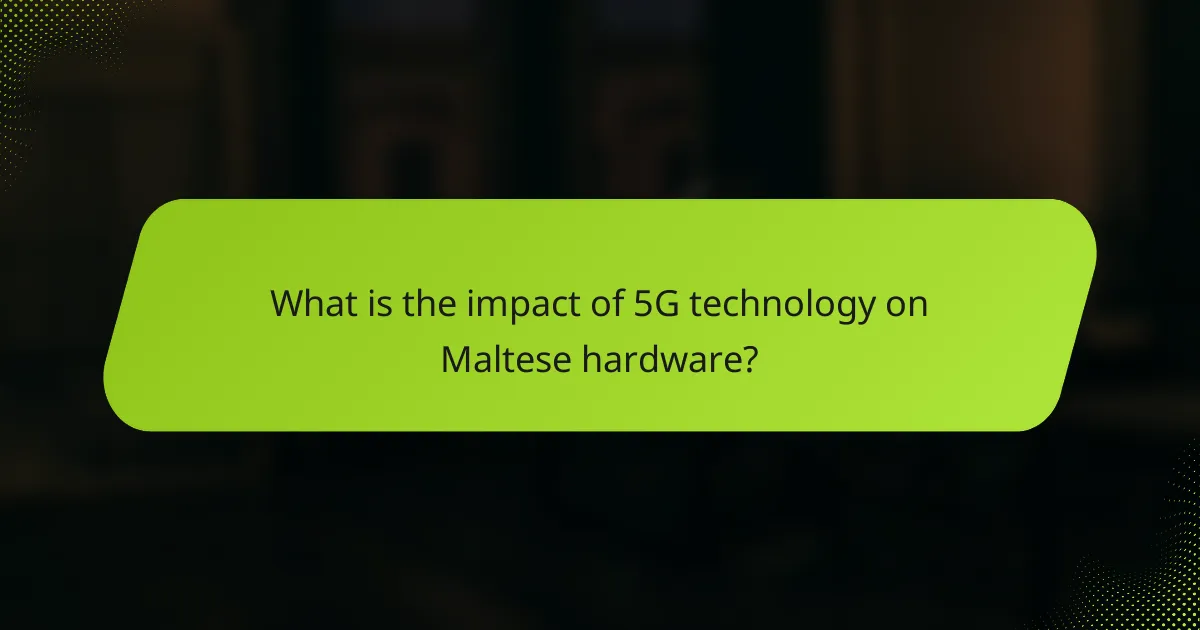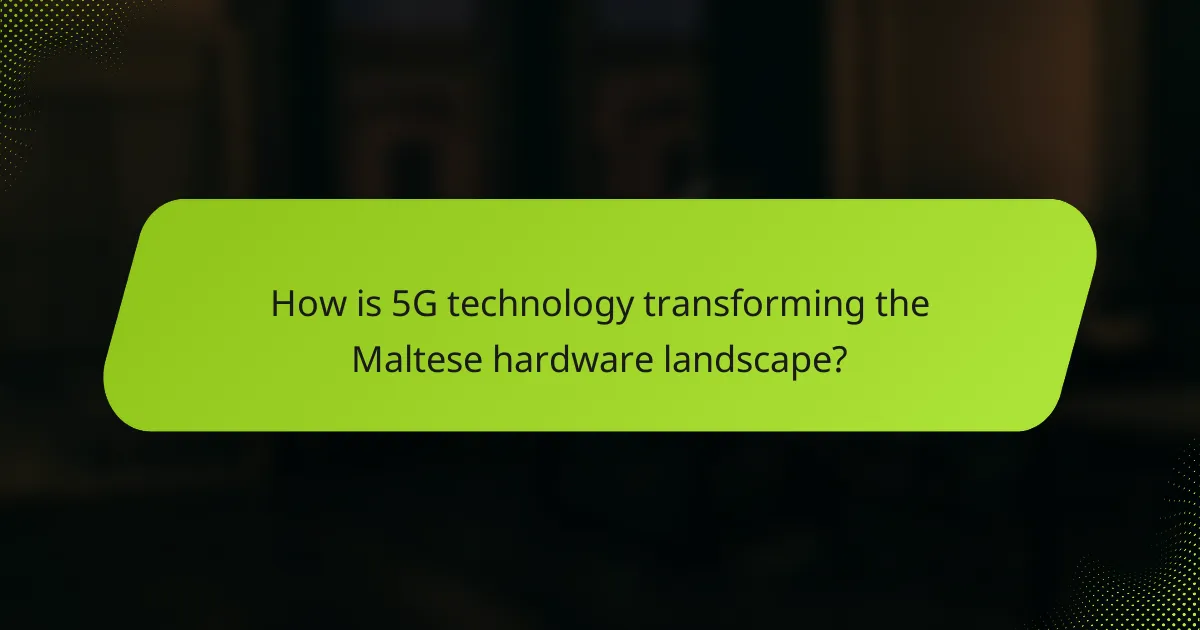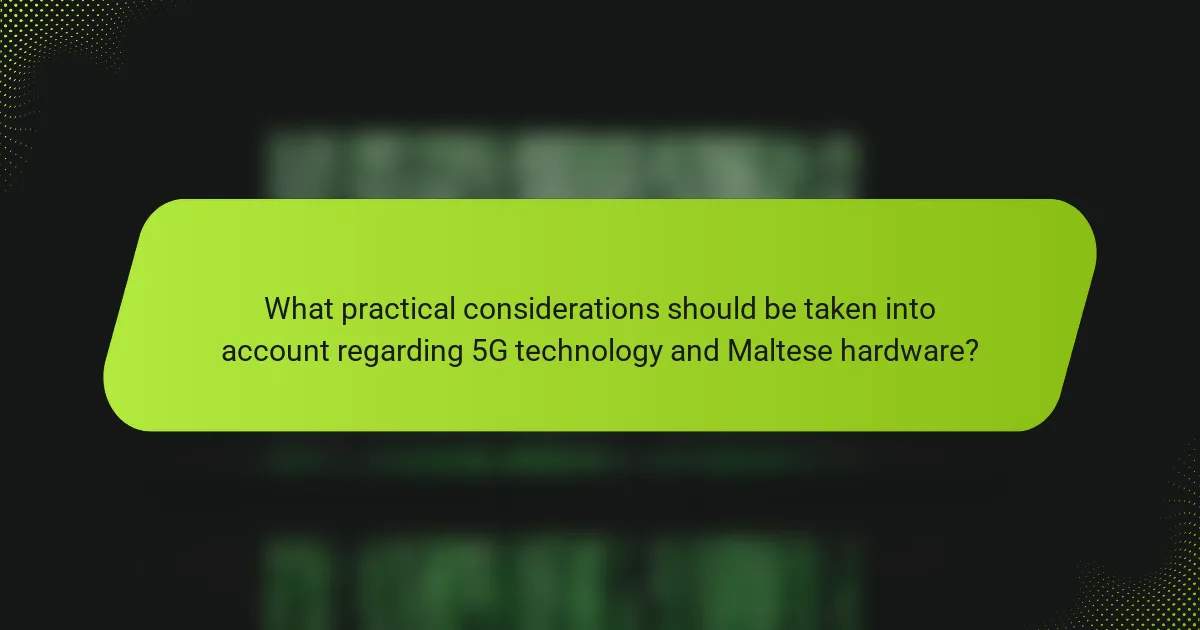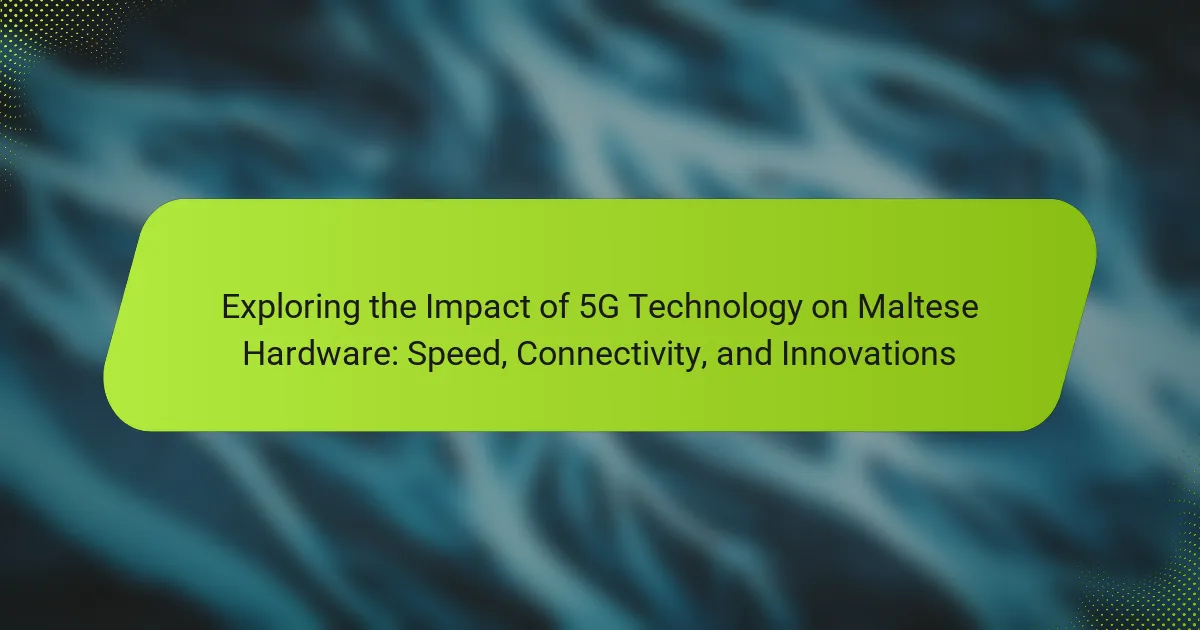
What is the impact of 5G technology on Maltese hardware?
5G technology significantly enhances Maltese hardware capabilities. It allows for faster data transmission rates, reaching up to 10 Gbps. This increase in speed improves the performance of devices such as smartphones and IoT gadgets. Moreover, 5G reduces latency to as low as 1 millisecond. This low latency is crucial for real-time applications like gaming and remote surgery. Additionally, 5G supports a higher density of connected devices. It can handle up to 1 million devices per square kilometer. This capability is vital for smart city initiatives in Malta. The overall impact of 5G leads to increased efficiency and innovation in Maltese hardware development.
How does 5G technology enhance speed in Maltese hardware?
5G technology enhances speed in Maltese hardware by providing significantly higher data transfer rates. It can achieve speeds up to 10 Gbps, which is substantially faster than previous generations. This increased speed allows for quicker downloads and smoother streaming of high-definition content. Furthermore, 5G reduces latency to as low as 1 millisecond, improving real-time communication and responsiveness. The enhanced capacity of 5G networks allows more devices to connect simultaneously without degrading performance. In Malta, this means that businesses can leverage faster internet for applications like cloud computing and IoT. The deployment of 5G infrastructure supports advanced technologies, driving innovation in various sectors.
What are the key speed metrics associated with 5G technology?
The key speed metrics associated with 5G technology include peak data rates, latency, and throughput. Peak data rates can reach up to 10 Gbps under optimal conditions. Latency in 5G networks is significantly reduced, averaging around 1 millisecond. Throughput measures the actual data transfer rate experienced by users, which can vary based on network conditions. 5G technology supports enhanced mobile broadband, enabling faster downloads and uploads compared to previous generations. These metrics highlight the advancements 5G brings to connectivity and speed.
How does speed improvement affect user experience in Malta?
Speed improvement significantly enhances user experience in Malta. Faster internet speeds reduce latency and improve connection stability. This allows for smoother streaming, quicker downloads, and more responsive applications. According to a report by the Malta Communications Authority, 5G technology can provide speeds up to 10 Gbps. This is a substantial upgrade from previous technologies. Enhanced speed supports more simultaneous connections, benefiting both individuals and businesses. Improved speed also facilitates advancements in smart city initiatives and IoT applications. Overall, speed improvements lead to greater user satisfaction and increased productivity in Malta.
What role does 5G technology play in connectivity for Maltese hardware?
5G technology significantly enhances connectivity for Maltese hardware. It offers faster data transfer speeds, reducing latency to milliseconds. This improvement allows devices to communicate more efficiently. The increased bandwidth supports more simultaneous connections. Maltese hardware can leverage 5G for IoT applications, enabling real-time data processing. Enhanced connectivity fosters innovation in sectors like healthcare and transportation. Statistics show that 5G can support up to one million devices per square kilometer. This capability is crucial for densely populated areas in Malta. Overall, 5G technology is pivotal for advancing Maltese hardware connectivity.
How does 5G improve connectivity in urban versus rural areas of Malta?
5G improves connectivity in urban areas of Malta by providing higher speeds and lower latency compared to rural areas. Urban regions, with their dense infrastructure, benefit from more 5G base stations. This results in faster data transfer rates, enabling seamless streaming and real-time applications. In contrast, rural areas experience limited 5G coverage, leading to slower speeds and higher latency. The technology allows for better support of IoT devices in urban settings, enhancing smart city initiatives. Statistics show that urban users can achieve speeds exceeding 1 Gbps, while rural users may struggle to reach 100 Mbps. Thus, the impact of 5G connectivity is significantly more pronounced in urban environments than in rural ones.
What are the implications of enhanced connectivity for local businesses?
Enhanced connectivity through technologies like 5G significantly benefits local businesses. It allows for faster data transfer, improving operational efficiency. Businesses can leverage real-time analytics to make informed decisions quickly. Enhanced connectivity facilitates better customer engagement through improved online services. It enables the use of advanced technologies like IoT, enhancing productivity. Local businesses can access a broader customer base through improved digital marketing strategies. Studies show that businesses adopting enhanced connectivity experience revenue growth. The McKinsey Global Institute reported a potential economic boost of $1.2 trillion from 5G technology in various sectors.
What innovations are driven by 5G technology in Maltese hardware?
5G technology drives several innovations in Maltese hardware. Enhanced connectivity enables faster data transfer rates. This leads to improved performance in smart devices and IoT applications. Low latency supports real-time communication in various sectors. Innovations include advancements in telecommunications infrastructure. New hardware designs accommodate increased bandwidth demands. Enhanced network reliability fosters growth in telemedicine and remote work solutions. These developments position Malta as a leader in adopting cutting-edge technology.
Which new hardware technologies are emerging as a result of 5G?
New hardware technologies emerging as a result of 5G include advanced antennas, edge computing devices, and IoT sensors. Advanced antennas, such as Massive MIMO, enhance signal capacity and coverage. Edge computing devices process data closer to the source, reducing latency. IoT sensors enable real-time data collection and communication in smart devices. These technologies support applications like autonomous vehicles and smart cities. The deployment of 5G networks drives innovation in these hardware solutions, facilitating faster and more reliable connectivity.
How are local startups leveraging 5G for innovation?
Local startups are leveraging 5G for innovation by developing applications that require high-speed connectivity. They are creating solutions in sectors like healthcare, agriculture, and smart cities. For instance, startups are using 5G to enhance telemedicine services with real-time data transmission. This technology allows for remote surgeries and consultations with minimal latency. Additionally, startups are implementing IoT devices that benefit from 5G’s increased bandwidth. These devices collect and analyze data more efficiently, improving operational processes. Furthermore, 5G enables augmented reality applications, enhancing user experiences in retail and education. The rapid data transfer capabilities of 5G are crucial for these innovative solutions.

How is 5G technology transforming the Maltese hardware landscape?
5G technology is significantly transforming the Maltese hardware landscape. It enhances connectivity and speeds up data transfer rates. This transformation enables the development of advanced hardware solutions. Manufacturers are innovating devices to leverage 5G capabilities. For instance, IoT devices are becoming more prevalent in Malta. These devices benefit from improved responsiveness and lower latency. Additionally, 5G supports the growth of smart city initiatives in Malta. This includes infrastructure improvements and enhanced public services. Overall, 5G is driving hardware innovation and connectivity in Malta.
What challenges does the implementation of 5G pose for Maltese hardware?
The implementation of 5G poses several challenges for Maltese hardware. One significant challenge is the need for upgraded infrastructure. Existing hardware may not support the high frequencies used in 5G technology. This necessitates substantial investments in new equipment. Additionally, there are concerns about compatibility with current devices. Not all existing hardware can seamlessly transition to 5G networks.
Another challenge is the increased demand for data processing capabilities. 5G networks can handle much higher data rates. This requires hardware to be more powerful and efficient. Furthermore, there are challenges related to latency. The low latency promised by 5G requires hardware that can process data rapidly.
Lastly, there are regulatory and technical hurdles. Compliance with new standards can be complex for manufacturers. Overall, the transition to 5G in Malta requires careful planning and investment in hardware upgrades.
What are the technical hurdles in upgrading existing hardware?
Upgrading existing hardware presents several technical hurdles. Compatibility issues often arise when integrating new components with older systems. Legacy systems may lack support for modern hardware standards. Performance bottlenecks can occur if the existing infrastructure cannot handle new technologies. Additionally, power supply constraints may limit the capability of older hardware. Data transfer rates can be hindered by outdated interfaces. Installation complexity increases with the need for specialized tools or skills. Lastly, potential downtime during upgrades can disrupt operations. These factors collectively complicate the process of upgrading hardware effectively.
How are regulatory issues affecting the rollout of 5G in Malta?
Regulatory issues are significantly impacting the rollout of 5G in Malta. Delays in obtaining necessary permits hinder infrastructure development. Compliance with EU regulations adds complexity to the deployment process. Local authorities often require extensive consultations before approving projects. This can slow down the installation of 5G equipment. Additionally, concerns about health and environmental impacts lead to stricter regulations. These factors collectively contribute to a slower rollout timeline for 5G services in Malta.
What future developments can we expect from 5G technology in Malta?
Future developments in 5G technology in Malta will likely include enhanced connectivity and increased data speeds. The Maltese government aims to expand 5G coverage to rural areas, improving access for all citizens. Additionally, advancements in smart city applications are expected, utilizing 5G for better urban management. The healthcare sector may see innovations with remote surgeries and telemedicine powered by 5G. Enhanced Internet of Things (IoT) capabilities will also emerge, facilitating smarter homes and businesses. Furthermore, new partnerships between telecom providers and tech companies will drive innovation in various industries. These developments are supported by Malta’s National Digital Strategy, which emphasizes the importance of 5G for economic growth.
How might 5G technology evolve in the next few years?
5G technology is expected to evolve significantly in the next few years. Enhanced speed and lower latency will become standard as networks upgrade infrastructure. More devices will connect simultaneously without degrading performance. This will enable advancements in IoT applications and smart city initiatives. Enhanced mobile broadband will support higher data rates for consumers. Additionally, network slicing will allow customized services for different industries. Security protocols will also improve to safeguard user data. The deployment of 5G will drive innovations in telemedicine, autonomous vehicles, and augmented reality.
What are the potential long-term benefits for Maltese consumers?
Maltese consumers can experience enhanced connectivity and faster internet speeds as long-term benefits of 5G technology. This technology significantly reduces latency, enabling real-time communication and improved online experiences. Enhanced connectivity supports the growth of smart devices and IoT applications in homes and businesses. Increased speed allows for high-definition streaming and seamless video conferencing. Additionally, improved network reliability can lead to better access to remote work and online education opportunities. Research indicates that 5G could boost the Maltese economy by facilitating innovation and attracting new investments. The European Commission estimates that 5G could contribute up to €1 trillion to the EU economy by 2025, benefiting consumers in Malta as well.

What practical considerations should be taken into account regarding 5G technology and Maltese hardware?
Practical considerations for 5G technology and Maltese hardware include compatibility, infrastructure, and security. Maltese hardware must support 5G frequencies and protocols. Upgrading existing infrastructure is essential for optimal performance. Latency and speed improvements are critical for various applications. Security measures must be enhanced to protect against vulnerabilities. Regulatory compliance is necessary for deployment. Collaboration with telecom providers ensures effective integration. Cost implications of upgrades should be assessed. These factors collectively influence the successful implementation of 5G in Malta.
What best practices should businesses follow to adapt to 5G technology?
Businesses should prioritize upgrading their infrastructure to support 5G technology. This includes investing in compatible hardware and software systems. They should also train employees on the capabilities and applications of 5G. Establishing partnerships with telecom providers will ensure reliable connectivity. Additionally, businesses must assess and adapt their data security measures for increased speed and connectivity. Implementing IoT solutions can enhance operational efficiency. Finally, continuously evaluating performance metrics will help optimize the use of 5G technology. These practices are essential for leveraging the full potential of 5G in business operations.
How can businesses ensure their hardware is 5G compatible?
Businesses can ensure their hardware is 5G compatible by verifying specifications. They should check for support of 5G frequency bands. Compatibility with both standalone and non-standalone modes is essential. Businesses must also ensure that devices have the necessary chipsets. These chipsets should be designed for 5G connectivity. Regular updates to firmware and software can enhance compatibility. Testing hardware with 5G networks is crucial for validation. Research indicates that devices certified by the Global Certification Forum are more likely to be compatible.
What strategies can be employed to maximize the benefits of 5G technology?
To maximize the benefits of 5G technology, entities should focus on infrastructure development, device compatibility, and application innovation. Investing in robust infrastructure ensures widespread coverage and reliability. Upgrading devices to support 5G capabilities enhances user experience and access. Additionally, fostering innovation in applications can leverage 5G’s low latency and high speed. For instance, industries such as healthcare can benefit from remote surgeries using 5G. Research indicates that countries with advanced 5G infrastructure see significant economic growth, highlighting the importance of strategic investments in this technology.
What common troubleshooting tips exist for Maltese hardware using 5G technology?
Common troubleshooting tips for Maltese hardware using 5G technology include checking device compatibility. Ensure the hardware supports 5G bands used in Malta. Restart the device to refresh the connection. Verify that the latest firmware is installed for optimal performance. Check for network coverage in the area to ensure 5G availability. Inspect SIM cards for damage or incorrect installation. Disable and re-enable mobile data settings to reset the connection. Lastly, consult the device manual for specific troubleshooting steps related to the hardware.
How can users resolve connectivity issues with 5G hardware?
Users can resolve connectivity issues with 5G hardware by troubleshooting their devices. First, ensure that the device is within range of a 5G signal. 5G networks operate on higher frequency bands that can be obstructed by physical barriers. Restarting the device can also help refresh the connection. Checking for software updates is crucial, as manufacturers often release patches that improve connectivity. Users should also verify their data plan supports 5G access. If issues persist, resetting network settings may resolve configuration problems. Finally, contacting the service provider for assistance can help identify network outages or service disruptions. These steps are validated by industry standards for troubleshooting connectivity issues in mobile networks.
What steps should be taken if hardware fails to utilize 5G capabilities?
Update the hardware to a model that supports 5G capabilities. Check if the current hardware’s specifications meet the requirements for 5G. Verify the software and firmware are updated to the latest versions. Ensure the device is configured correctly for 5G networks. Test the SIM card to confirm it is 5G-compatible. Consult the manufacturer’s guidelines for any specific settings required for 5G. If issues persist, contact customer support for assistance. Consider replacing the hardware if it is unable to support 5G after troubleshooting.
The main entity of this article is 5G technology and its impact on Maltese hardware. The article explores how 5G enhances speed, connectivity, and innovation within the hardware landscape in Malta, highlighting key metrics such as peak data rates of up to 10 Gbps and reduced latency to 1 millisecond. It discusses the implications for local businesses, the challenges of implementation, and the emerging hardware technologies that are driven by 5G advancements. Additionally, the article addresses practical considerations for businesses adapting to 5G and outlines future developments expected from this transformative technology.
